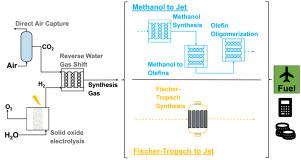当前位置:
X-MOL 学术
›
Energy Convers. Manag.
›
论文详情
Our official English website, www.x-mol.net, welcomes your
feedback! (Note: you will need to create a separate account there.)
Techno-economic assessment and comparison of Fischer–Tropsch and Methanol-to-Jet processes to produce sustainable aviation fuel via Power-to-Liquid
Energy Conversion and Management ( IF 9.9 ) Pub Date : 2024-07-03 , DOI: 10.1016/j.enconman.2024.118728 Vincent Eyberg , Vincent Dieterich , Sebastian Bastek , Marcel Dossow , Hartmut Spliethoff , Sebastian Fendt
Energy Conversion and Management ( IF 9.9 ) Pub Date : 2024-07-03 , DOI: 10.1016/j.enconman.2024.118728 Vincent Eyberg , Vincent Dieterich , Sebastian Bastek , Marcel Dossow , Hartmut Spliethoff , Sebastian Fendt

|
The aviation sector accounts for about 3% of global CO emissions and aviation emissions will further increase as air travel is predicted to grow in the future. Planes are difficult to electrify, therefore sustainable aviation fuel (SAF) will be an option to defossilize aviation. In this study, Power-to-Liquid (PtL) routes with Fischer–Tropsch (FT) and Methanol-to-Jet (MtJ) fuel synthesis are considered as SAF production pathways, with CO from Direct Air Capture (DAC) and H from Solid Oxide Electrolysis (SOEL) as educts. The processes are modeled in Aspen Plus V12, optimized configurations are developed and the routes are techno-economically assessed. Process options with reforming and recycling of gaseous products are identified as beneficial. MtJ and FT routes show different advantages and disadvantages, but the main technical and economical results indicate that the routes are similarly suitable for the synthesis of SAF. Comparing the base cases to the optimal configurations, the energy and carbon efficiencies are increased from 30% to 40% and 60% to 90%, respectively. With the baseline economic parameters, the Levelized Cost of Production (LCOP) is ▪ . In an optimistic estimation with SOEL cost projection for 2050 and electricity costs of ▪ , the LCOP is lowered to about ▪ , which is about three times higher as today’s costs of fossil jet fuel.
中文翻译:

通过电转液生产可持续航空燃料的费托合成工艺和甲醇喷射工艺的技术经济评估和比较
航空业约占全球二氧化碳排放量的3%,随着未来航空旅行的增长,航空排放量还将进一步增加。飞机很难电气化,因此可持续航空燃料(SAF)将成为航空业去石化的一个选择。在本研究中,采用费托合成 (FT) 和甲醇制喷气燃料 (MtJ) 燃料合成的电转液 (PtL) 路线被认为是 SAF 生产途径,其中 CO 来自直接空气捕获 (DAC),H 则来自直接空气捕获 (DAC)。固体氧化物电解 (SOEL) 作为离析物。在 Aspen Plus V12 中对流程进行建模,开发优化配置并对路线进行技术经济评估。气体产物的重整和回收的工艺选项被认为是有益的。 MtJ和FT路线显示出不同的优缺点,但主要技术和经济结果表明,该路线同样适合SAF的合成。将基本情况与最佳配置进行比较,能源效率和碳效率分别从 30% 提高到 40%,从 60% 提高到 90%。根据基准经济参数,平准化生产成本 (LCOP) 为 ▪ 。根据 2050 年 SOEL 成本预测和 ▪ 电力成本的乐观估计,LCOP 降低至约 ▪ ,这大约是当今化石航空燃料成本的三倍。
更新日期:2024-07-03
中文翻译:

通过电转液生产可持续航空燃料的费托合成工艺和甲醇喷射工艺的技术经济评估和比较
航空业约占全球二氧化碳排放量的3%,随着未来航空旅行的增长,航空排放量还将进一步增加。飞机很难电气化,因此可持续航空燃料(SAF)将成为航空业去石化的一个选择。在本研究中,采用费托合成 (FT) 和甲醇制喷气燃料 (MtJ) 燃料合成的电转液 (PtL) 路线被认为是 SAF 生产途径,其中 CO 来自直接空气捕获 (DAC),H 则来自直接空气捕获 (DAC)。固体氧化物电解 (SOEL) 作为离析物。在 Aspen Plus V12 中对流程进行建模,开发优化配置并对路线进行技术经济评估。气体产物的重整和回收的工艺选项被认为是有益的。 MtJ和FT路线显示出不同的优缺点,但主要技术和经济结果表明,该路线同样适合SAF的合成。将基本情况与最佳配置进行比较,能源效率和碳效率分别从 30% 提高到 40%,从 60% 提高到 90%。根据基准经济参数,平准化生产成本 (LCOP) 为 ▪ 。根据 2050 年 SOEL 成本预测和 ▪ 电力成本的乐观估计,LCOP 降低至约 ▪ ,这大约是当今化石航空燃料成本的三倍。

































 京公网安备 11010802027423号
京公网安备 11010802027423号